This report is authored by Tiger Research and analyzes how Canton Network bridges the gap between blockchain idealism and the realities of financial institutions through a selectively transparent architecture and compliant infrastructure.
Key Points Summary
- Addressing the mismatch between blockchain and institutions: The complete transparency and decentralization of traditional blockchains conflict with financial institutions' requirements for privacy, regulatory compliance, and control, limiting their application to pilot stages.
- Achieving a selectively transparent architecture: The "public permission" model combined with Daml smart contracts allows for transaction-level privacy control, meets Basel regulatory standards, and supports institutional workflows through a rights and obligations framework.
- Reaching true institutional scale: With over 400 institutions and more than $6 trillion in tokenized assets, processing 3 million transactions daily, major players including Bank of America have engaged in 24/7 on-chain treasury trading since its launch in 2024.
1. Between Blockchain Idealism and Reality
From the beginning, blockchain technology has been built around two core principles: 1) complete transparency, where all transactions are publicly visible; 2) decentralization, where the system operates without central control. While these ideals shaped the early development of blockchain, reality has significantly diverged.
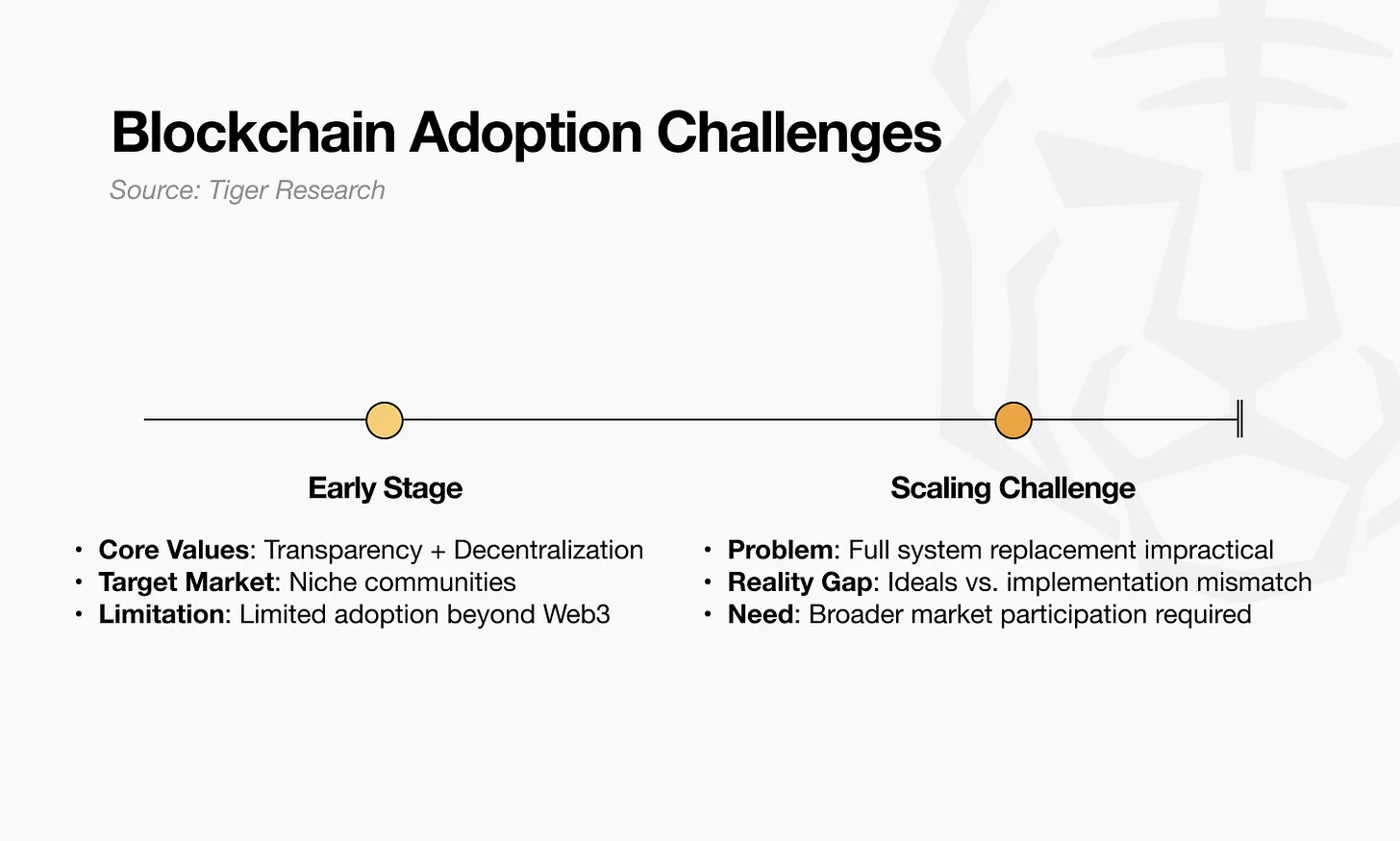
In the early stages, early adopters developed services around transparency and decentralization. However, adoption was limited to niche communities. As broader participation became necessary, it became clear that completely replacing existing systems with blockchain infrastructure was impractical.
The challenges are even more severe for financial institutions. Complete transparency means that trading strategies and corporate financial data could be exposed. Decentralization conflicts with the need for control and management.
Thus, the fundamental ideals of blockchain conflict with institutions' requirements for privacy, oversight, regulatory compliance, and scalability. Institutions recognize clear benefits—such as real-time settlement and capital efficiency—but most remain in pilot stages.
However, sustained growth cannot rely on a small group of idealistic supporters. Institutional adoption and broader market expansion require a focus on practical needs rather than philosophical purity.
2. Canton Network: A Pragmatic Approach
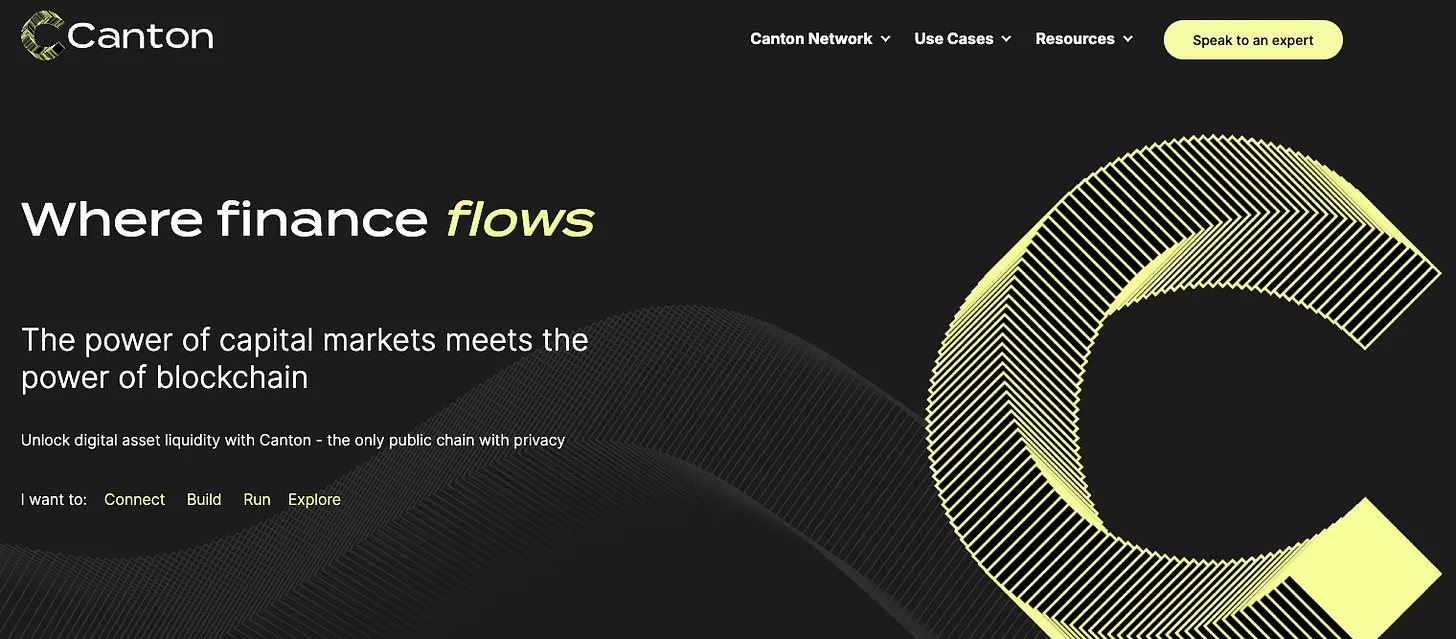 Source: Canton Network
Source: Canton Network
The emergence of Canton Network aims to address the tension between blockchain ideals and institutional realities. Unlike early blockchains that relied on absolute models, it introduces flexibility, allowing institutions to choose how to manage information and control.
This approach reflects the practical needs of financial institutions. Some information must be fully transparent to regulators but shielded from competitors. Customer privacy must be protected while still allowing for internal audits. Traditional blockchains adopt a binary model of either complete disclosure or complete opacity, failing to meet these nuanced requirements.
Canton Network differentiates itself through the Canton protocol, which enables institutions to meet regulatory requirements and manage risks while retaining the advantages of real-time settlement and capital efficiency offered by blockchain. This makes it an infrastructure that supports the transition from pilot projects to large-scale institutional adoption.
At its core, the Canton protocol supports independent control over applications and transactions, achieving configurable privacy through a unique "proof of stake" consensus model and enabling interoperability between independently operating systems.
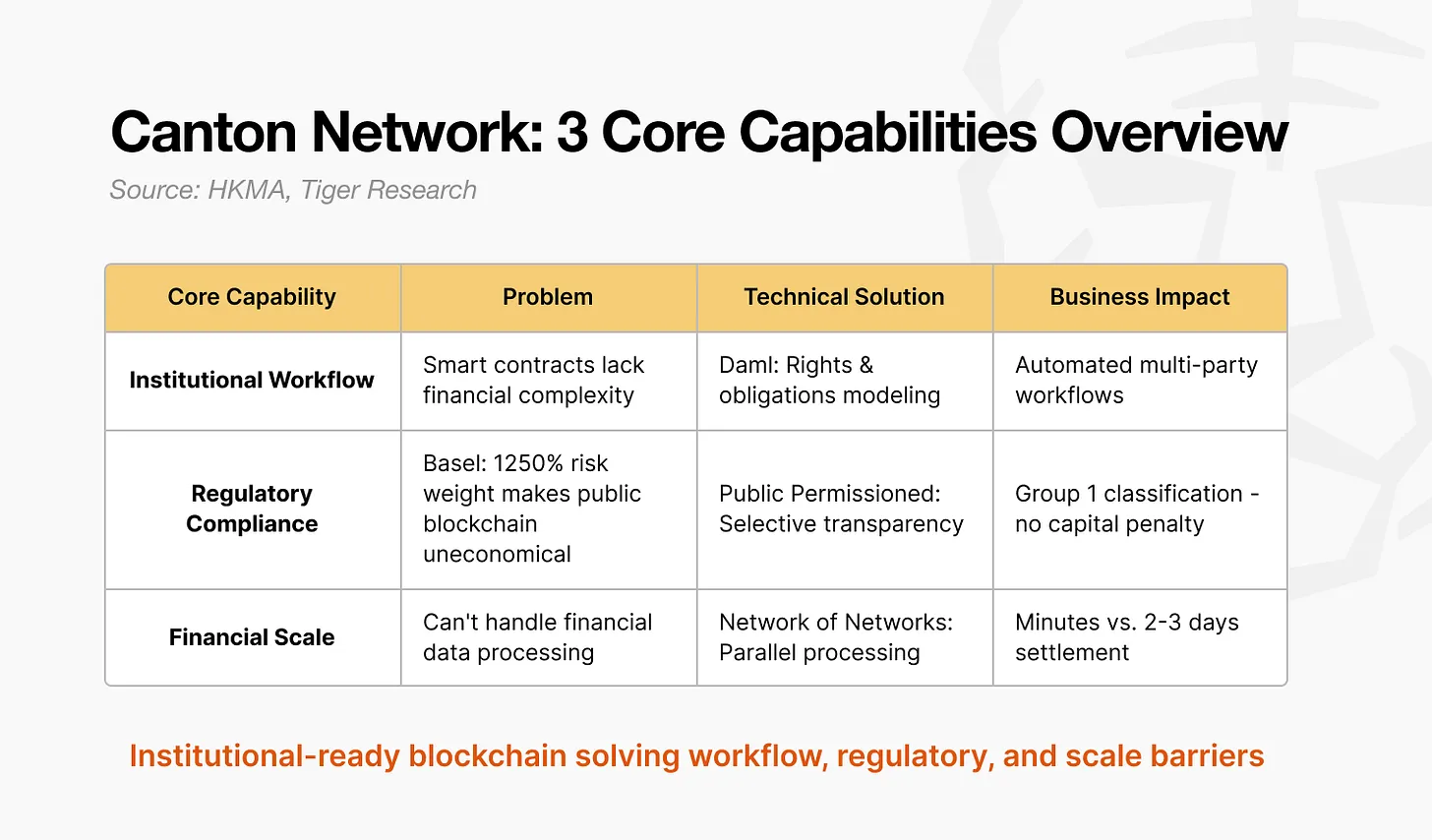
2.1. Institutional Workflow Design
This is achieved through Daml, a functional programming language designed specifically for securely and efficiently automating multi-party financial workflows. By leveraging Daml, Canton Network provides an alternative to existing smart contract frameworks (like Ethereum's Solidity), offering an architecture tailored for institutional use cases.

Daml builds contracts around rights and obligations, directly aligning with the nature of financial transactions. Each financial agreement can be broken down into the transfer of rights and a set of obligations.
For example, in a lease agreement, the tenant has the right to occupy the apartment but is obligated to pay maintenance fees; the landlord has the right to collect a deposit but is obligated to provide the right to use the property. Daml precisely encodes such relationships in an executable form.
Daml and Canton work together to connect different systems into a single automated workflow through smart contract-level atomic composability. In this model, all interdependent steps either succeed together or fail together, ensuring the integrity of the transaction.
A real estate transaction illustrates this: once the buyer deposits funds, the loan review automatically begins; upon approval, the property transfer continues. Each stage is bound by clearly defined rights and obligations, and the entire process is viewed as an indivisible transaction. If any step fails, the system reverts to its original state.
Equally important is the system's flexibility and controllability. Contracts can be modified with the agreement of both parties to accommodate unexpected changes, such as regulatory shifts or court rulings.
By leveraging Daml, Canton Network provides the operational conditions institutions need: clear definitions of rights and obligations, practical workflows, and built-in adaptability and governance mechanisms. This enables institutions to meet compliance and privacy requirements without sacrificing efficiency.
2.2. Regulation and Privacy
One of the main barriers to blockchain adoption by financial institutions is regulation, closely tied to data privacy and operational control. One of the most significant obstacles is the Basel Accord, an international standard set by the Basel Committee on Banking Supervision under the Bank for International Settlements. Although not legally binding, these standards are often implemented through national legislation, giving them practical effect.
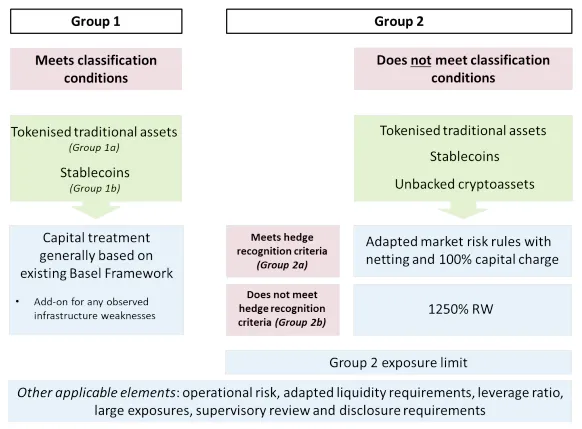
Source: Basel Rules
According to Basel rules, unsecured assets issued on public blockchains fall into "Group 2," with a risk weight of up to 1250%. In practice, this means that holding blockchain assets worth 100 million KRW requires 1.25 billion KRW in regulatory capital, making large-scale use uneconomical.
Canton Network addresses this issue through a "public permission" architecture. Just as the internet is open but restricts access to sensitive platforms like banking websites, Canton combines openness with fine-grained access control.
This is achieved through the aforementioned sub-transaction-level privacy features. Only the parties directly involved in a transaction can view and record specific data related to it, while other participants can only see the information they need to know. For example, in a securities settlement transaction, the bank can only view the cash transfer portion, while the securities depository can only view the securities transfer portion.
Daml smart contracts allow for fine-grained control over data access and operations, ensuring that tokenized traditional assets qualify as "Group 1" risk exposures, thereby avoiding punitive capital costs. The same mechanism also supports selective disclosure to auditors, enabling oversight without compromising confidentiality.
Thus, Canton resolves the key trade-off issues that constrained early blockchains. The complete transparency of public chains compromises confidentiality, while the complete opacity of private chains hinders interoperability. By providing selective transparency, Canton enables institutions to comply with regulations while protecting privacy.
2.3. Performance at Scale for Financial Systems
For blockchain to be viable in capital markets, its operational scale must match that of existing financial infrastructure. The daily trading volume in foreign exchange alone exceeds $7.5 trillion, with total trading volumes in stocks, bonds, and derivatives reaching hundreds of trillions of dollars. Therefore, institutions need a blockchain system that can match existing performance benchmarks, remain stable during peak periods, and support 24/7 continuous operation.
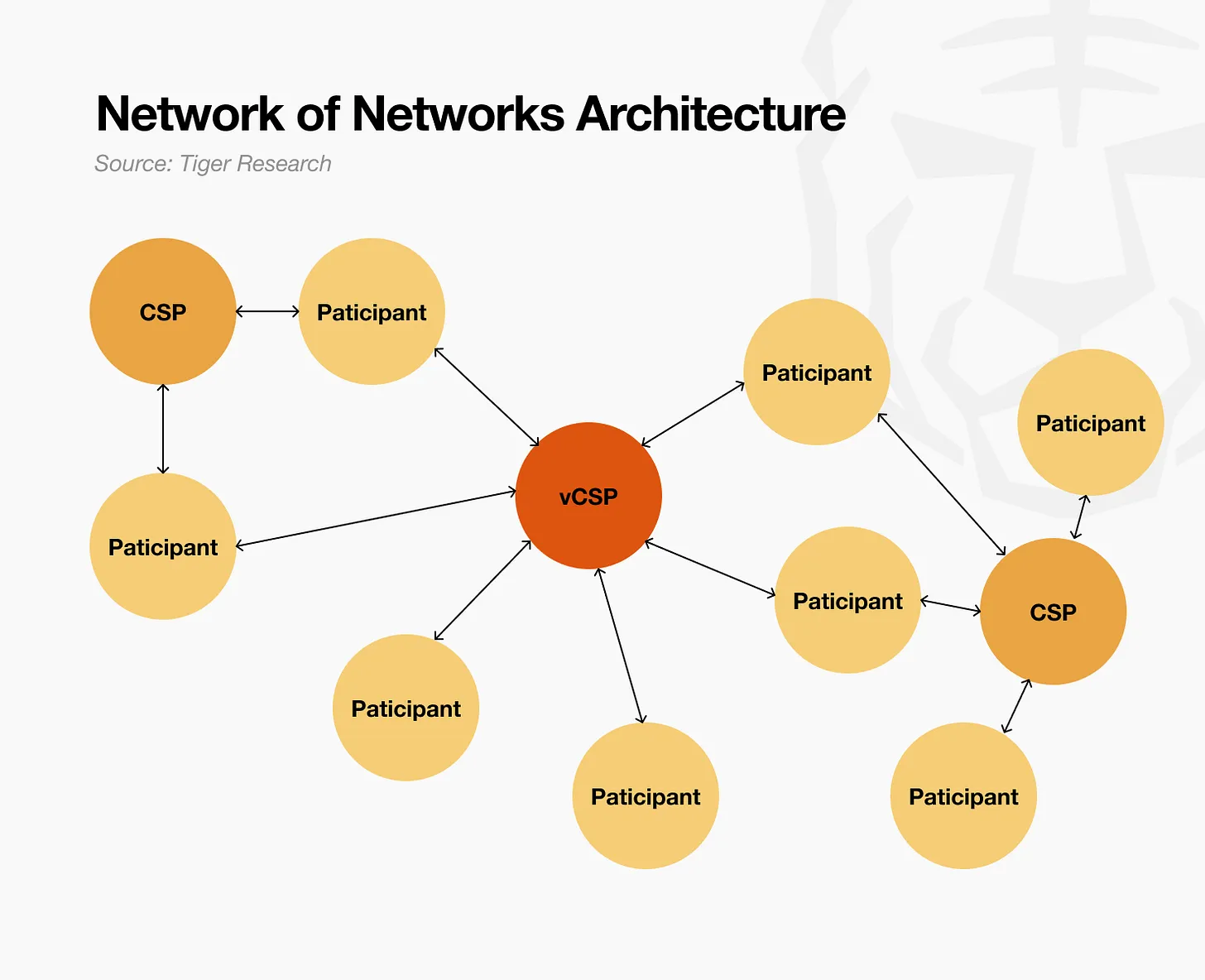
Canton Network addresses this need through a "network of networks" architecture. Unlike traditional blockchains that operate as a single cohesive system, Canton’s structure resembles a transportation network, with multiple sub-networks interconnected to balance loads and ensure resilience.
- Participant Nodes: Nodes representing institutions that only validate their own transactions and can securely host multiple parties.
- CSPs: Regional infrastructure providers that connect participant nodes and offer services compliant with local regulatory requirements.
- vCSP: A global synchronization layer providing a public backbone for cross-application and cross-regional settlements, with the first production instance currently operated by over 30 major institutions.
This layered design functions similarly to a city traffic system. Participant nodes are akin to buildings, CSPs act as regional road networks, and vCSP serves as the highways connecting regions. Nodes can connect to multiple CSPs, and if one path is congested, transactions can be rerouted, with capacity expanded by adding new CSPs.
A cross-border transaction between Samsung and Apple illustrates this process.
Samsung's node connects to a Korean CSP holding digital won, while Apple's node connects to a U.S. CSP holding digital dollars. Both are also connected to the global vCSP. When Apple places an order, the smart contract deposits $100,000 into an escrow account. Once Samsung confirms shipment, the funds in the escrow account are automatically released to Samsung. The entire process is completed within minutes, whereas traditional international wire transfers typically take two to three days.
Here, the Korean CSP verifies Samsung's won activity, the U.S. CSP verifies Apple's dollar activity, and the vCSP ensures atomic settlement between the two networks. Meanwhile, other CSPs can handle unrelated transactions (e.g., LG-Sony or Google-Microsoft transactions), thereby multiplying the system's throughput. As CSPs operate independently, overall capacity expands with the number of providers.
This parallelization approach supports concurrent execution across synchronized domains. Currently, Canton processes over 4 transactions per second and has recorded more than 3.5 million events related to Canton Coin in a single day. Digital Asset and its institutional partners have successfully executed on-chain U.S. Treasury trades and repurchase transactions, demonstrating continuous settlement capabilities even on weekends.
3. Building the Canton Ecosystem
Canton Network addresses the classic "chicken or egg" problem in blockchain adoption, where services do not emerge without users, and users do not join without services. It achieves this through a unique incentive and distribution model.
At its core is Canton Coin, the native digital currency of the network. Unlike many blockchain project tokens that are pre-mined and disproportionately allocated to founders or venture capitalists, the distribution of Canton Coins is entirely based on contributions to the network. There is no pre-allocation to venture capital or foundations. Participants can only earn tokens by providing tangible value—whether through operating infrastructure, developing applications, or conducting transactions. In practice, the distribution resembles paying wages for completed work.

Source: Cantonscan
The second feature is a balance mechanism between destruction and minting. Transaction fees paid by users are destroyed, permanently reducing supply, while new tokens are minted as rewards for contributors. This creates a balance between scarcity driven by usage and issuance driven by contributions.
The reward distribution also evolves over time. In the early stages, higher rewards are allocated to super validators responsible for building the network infrastructure. As the system stabilizes, the share of rewards shifts towards developers building applications and services. This is similar to the development of a new city, where initial investments focus on roads and utilities, followed by the growth of retail and service providers.
4. The Path Forward for Canton Network
Since its official launch in July 2024, Canton Network has demonstrated strong growth momentum by proving its practical value to financial institutions (not just technological milestones).

Source: Cryptodiffer
This progress is reflected in financing. In June 2025, Canton raised $135 million led by DRW Trading and Tradeweb, with extensive participation from major traditional financial companies. These institutions are not only investors but also active contributors to service and operations development.
The value of the assets processed is even more astonishing. Tokenized assets on Canton exceed $6 trillion, larger than the GDP of most countries. The network also processes over $280 billion in U.S. Treasury repurchase transactions daily.
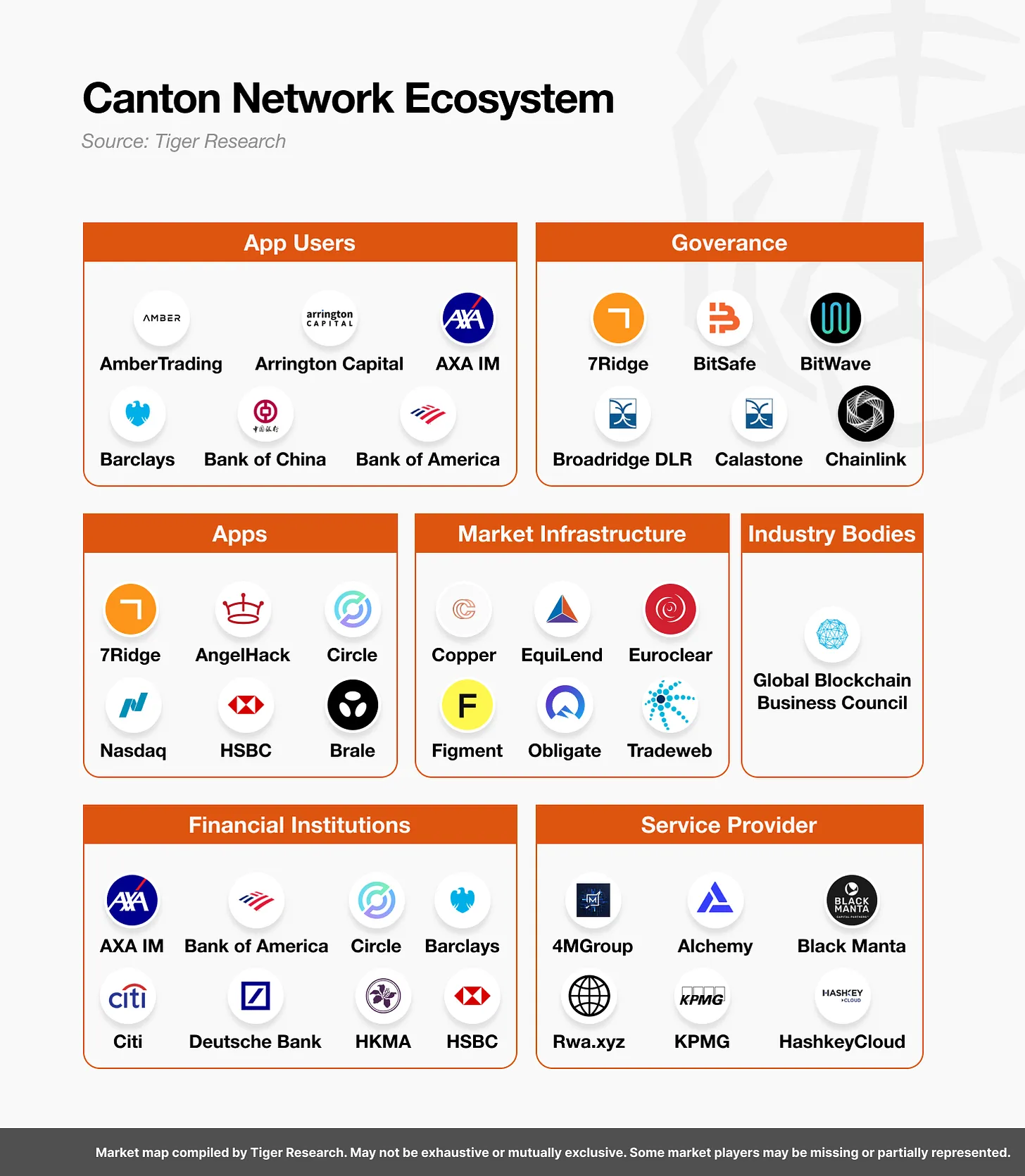
Specific use cases are emerging. On August 12, 2025, Bank of America, Circle, Citadel Securities, DTCC, Société Générale, and Tradeweb executed the first weekend on-chain financing transaction involving U.S. Treasuries and USDC, marking the emergence of a 24/7 capital market.
Stablecoin settlement is another attractive area. Circle has integrated USDC with Canton, emphasizing the role of privacy controls, while Paxos has joined as a validator. Institutions highlight the ability to maintain confidentiality in transaction details while meeting regulatory requirements in inter-company payments.
Looking ahead, broader adoption is expected, particularly in the tokenization of RWA (Real World Assets). Real estate, commodities, and artworks are likely to follow, elevating liquidity far beyond the current $6 trillion that has been tokenized.
In the long term, Canton points to a blockchain-based, around-the-clock global capital market, unrestricted by time zones or national borders. Developments like Nasdaq's application to support tokenized equity underscore this shift.
Thus, Canton positions itself as the optimized infrastructure for the current transformation—bridging the advantages of blockchain with the requirements of institutions. Its trajectory will depend on how effectively it continues to balance ideals with real-world demands.
免责声明:本文章仅代表作者个人观点,不代表本平台的立场和观点。本文章仅供信息分享,不构成对任何人的任何投资建议。用户与作者之间的任何争议,与本平台无关。如网页中刊载的文章或图片涉及侵权,请提供相关的权利证明和身份证明发送邮件到support@aicoin.com,本平台相关工作人员将会进行核查。



